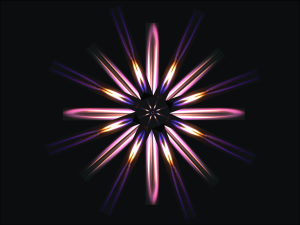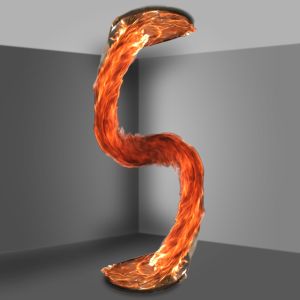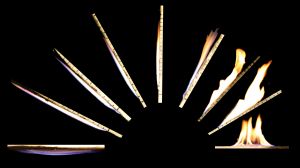
“Microgravity flames converging toward the center of the starburst ‘implode’ against an outflow of wind, creating a diffusion flame ‘supernova’.”
Sandra L. Olson (NASA Glenn Research Center)

“A family of methane-air counterflow and premixed flames of different configurations with and without addition of nanoparticles. Depending on flame configuration, the particles may pass reaction zone, be heated and irradiate light (nose, beard, and hair). In certain configurations of a counterflow diffusion flame, the reaction zone acts as a strong fluid-dynamics source and diverts the particles, making them not reach the reaction zone (eyes and mouth). A classical methane-air diffusion flame provides Dr. Combustion with an elegant hat as he cannot conceal the joy of discovery.”
Bogdan Pavlov and Li Qiao (Purdue University)

“A fire whirl developed over a pool of benzene, note the waves and disturbances on the fuel surface. An upward mirrored reflection of the whirl is rotated to create the s-like shape.”
Nelson Akafuah and Kozo Saito (University of Kentucky)

“This “fan of fire” visually displays the effect gravity has on upward flame spread over thermally-thick materials. Starting from the left “ceiling fire”, as the inclination angle or tilt of a burning surface is increased underside flames transition from blue, well-mixed laminar flames into increasingly turbulent yellow flames on the topside that “lift” from the surface dramatically increasing the flame thickness. These images were taken perpendicular to the surface of a thick sample of Polymethyl Methacrylate mounted flush into insulation board as flames spread upward. These tests have helped in finding critical inclinations with maximum flame spread rates, burning rates and heat fluxes from the flame.”
Michael Gollner and Xinyan Huang (University of California, San Diego)